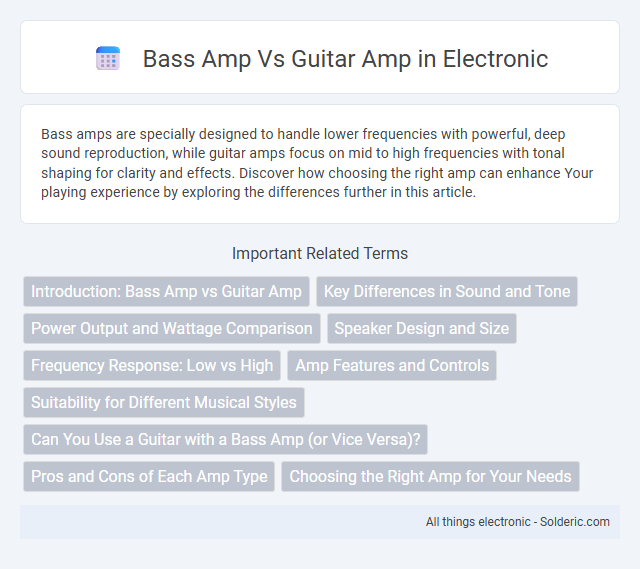Bass amps are specially designed to handle lower frequencies with powerful, deep sound reproduction, while guitar amps focus on mid to high frequencies with tonal shaping for clarity and effects. Discover how choosing the right amp can enhance Your playing experience by exploring the differences further in this article.
Comparison Table
| Feature | Bass Amp | Guitar Amp |
|---|---|---|
| Frequency Range | 20 Hz - 4 kHz (low frequencies emphasized) | 80 Hz - 5 kHz (mid to high frequencies emphasized) |
| Speaker Size | 10" to 15" (larger for bass response) | 8" to 12" (smaller for precise mids/highs) |
| Power Output | 300W to 1500W (high wattage for low-end clarity) | 15W to 100W (varies for clean to distortion tones) |
| Wooden Cabinet Design | Sturdy, enhances low-frequency resonance | Designed for tonal color and distortion |
| EQ Controls | Focus on bass, mid, treble controls | More detailed EQ (presence, contour, gain) |
| Use Case | Ideal for bass guitars and low-frequency instruments | Best for electric/acoustic guitars and tone shaping |
| Distortion | Minimal distortion, clean sound preference | Often includes built-in distortion and effects |
Introduction: Bass Amp vs Guitar Amp
Bass amps and guitar amps differ significantly in design and frequency response to accommodate their respective instruments. Bass amps emphasize low-frequency output and robust power handling to reproduce deep bass tones without distortion, while guitar amps focus on midrange clarity and tonal shaping for varied guitar sounds. Understanding these distinctions helps you choose the right amp for optimal performance and sound quality.
Key Differences in Sound and Tone
Bass amps deliver deeper, richer low frequencies designed to handle the sub-bass range, providing clarity and power without distortion at high volumes. Guitar amps focus on midrange tones with a broader frequency spectrum, allowing for more dynamic overdrive and tonal shaping suitable for solos and rhythm playing. Your choice depends on the instrument's frequency response and the desired sound texture for performances or recordings.
Power Output and Wattage Comparison
Bass amps typically feature higher power output and wattage compared to guitar amps, often ranging from 100 to 500 watts to handle low-frequency sound waves effectively. Guitar amps generally operate within 15 to 100 watts, optimized for mid to high frequencies and tonal clarity. Higher wattage in bass amplifiers ensures better headroom and dynamic range to reproduce deep bass tones with minimal distortion.
Speaker Design and Size
Bass amps typically feature larger speaker sizes ranging from 10 to 15 inches, designed to handle lower frequencies with enhanced cone rigidity and deeper voice coils to prevent distortion. Guitar amps generally use smaller speakers between 8 to 12 inches, optimized for mid to high frequencies with paper or composite cones that emphasize clarity and tonal warmth. The speaker design in bass amps prioritizes durability and low-end response, while guitar amps focus on dynamic range and harmonic content.
Frequency Response: Low vs High
Bass amps are designed to handle low-frequency ranges typically between 40 Hz and 400 Hz, delivering deep, powerful tones essential for bass guitars. Guitar amps focus on higher frequency ranges, roughly spanning 80 Hz to 1200 Hz, to accurately reproduce the midrange and treble tones characteristic of guitars. The difference in frequency response ensures each amp type enhances its instrument's tonal qualities without distortion or loss of clarity.
Amp Features and Controls
Bass amps typically feature specialized controls such as contour or mid-shift knobs that tailor the low-frequency response to preserve the instrument's deep tones, while guitar amps emphasize midrange-focused EQ controls for clarity and distortion shaping. Bass amplifiers often have higher wattage and larger speaker sizes to handle low-end frequencies without distortion, along with built-in compressors and limiters to maintain signal integrity. Guitar amps generally include effects loops, gain stages, and presence controls to enhance tonal versatility and overdrive characteristics.
Suitability for Different Musical Styles
Bass amps are specifically designed to handle low-frequency sounds, making them ideal for genres like funk, reggae, and metal where deep, punchy bass lines are essential. Guitar amps emphasize mid and high frequencies, enhancing clarity and distortion suited for rock, blues, and jazz styles. Your choice should align with the instrument and musical style to achieve the best tonal performance and sound clarity.
Can You Use a Guitar with a Bass Amp (or Vice Versa)?
Using a guitar with a bass amp is possible but may result in altered tone due to the amp's frequency response designed for lower bass frequencies. Conversely, plugging a bass guitar into a guitar amp can damage the speaker because guitar amps are not built to handle the low-end power and extended range of bass signals. Your choice depends on sound preference and equipment durability, but ideally, using each instrument with its corresponding amp ensures optimal performance and longevity.
Pros and Cons of Each Amp Type
Bass amps deliver deep, powerful low frequencies designed to handle the extended range of bass guitars, providing clear, punchy sound but they are often heavier and less versatile for other instrument types. Guitar amps excel at shaping tonal characteristics with built-in effects and distortion, offering versatility and dynamic response, yet may lack the necessary low-end power for bass instruments. Your choice depends on whether you prioritize low-frequency clarity and volume for bass or tonal versatility and effects for guitar.
Choosing the Right Amp for Your Needs
Choosing the right amp depends on the instrument you play, as bass amps are designed to handle low frequencies with powerful speakers and specific tonal controls, while guitar amps emphasize midrange clarity and distortion effects. Your choice should consider the genre and volume requirements, with bass amps providing deep, punchy sounds ideal for rhythm sections and guitar amps delivering versatile tonal shaping for lead or rhythm parts. Matching the amp to your instrument's unique frequency range ensures optimal sound quality and performance during practice or live shows.
bass amp vs guitar amp Infographic

 solderic.com
solderic.com